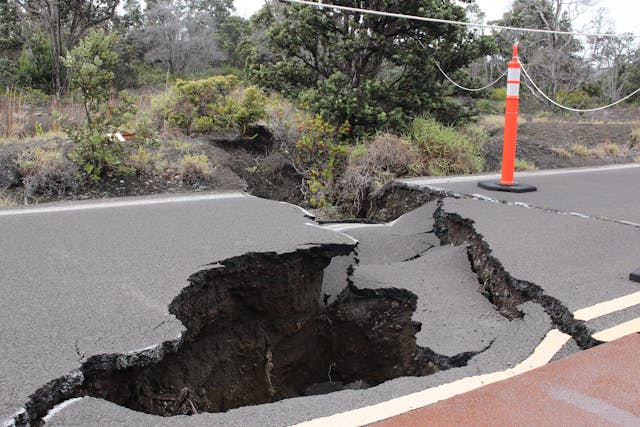
How does an earthquake early warning system work? An earthquake early warning system works by detecting the P wave that comes from the earthquake’s epicenter.
Earthquakes are caused when tectonic plates jam against each other and then suddenly move. There are three types of tectonic plate boundaries. There are divergent boundaries. These are where two plates are moving away from each other and they don’t cause earthquakes. Magma and rock come up through the gap between the plates and new land is formed. These usually happen under the sea. Then there are transform plate boundaries. These happen when two plates are moving next to each other in opposite directions. They can sometimes jam and then come loose, which causes earthquakes, but not the big ones and not very deep ones. The third type of boundary is a convergent plate boundary. This is where one plate rises up and drives the other plate down. The less dense land plate is always pushed up and the more dense sea plate is pushed down into the earth. Where they meet, the edge of the land plate ruckles up, forming mountains. These plates can jam against each other for hundreds of years before they suddenly break free and move with a jerk. While they are jammed together, the parts of the plates behind the jammed bit are still moving and the energy at the edge of the plate slowly builds up. This energy is called stored elastic strain energy. When they snap free and move, all of this energy is released, and that is an earthquake.
The effects of the earthquake on us are governed by how deep it is and how much energy there was. The deeper the earthquake, the better for us because a lot of that energy will be absorbed before it does much damage on the surface. Shallow quakes with a lot of energy are the worst. The biggest earthquake ever was a 9.5 earthquake in Chile in 1960. It killed close to 6,000 people and triggered multiple tsunamis as well. These days, we obviously still have very powerful earthquakes, but we get more warning than people used to and that can be the difference between being trapped in a collapsing building and being able to escape. The warnings come in many forms, but a lot of us get an alert on our smartphones. How is that possible?
The main reason this is possible is that, depending on where the earthquake strikes, there can be some time between the detection of the earthquake and when the actual earthquake hits. This can be as high as 90 seconds. When the tectonic plates move and the energy is released, it travels through the ground in ripples. These are what cause the damage. The ripples travel through the ground at only a few kilometers a second. The sudden energy release also creates a pressure wave which travels through the ground ahead of the ripples. This is called the P wave and it travels much faster than the energy wave. Depending on the material it is traveling through, it can be anywhere between 4.6 km per second to 7.2 km a second. That means, the P wave will arrive far before the earthquake. The P wave is picked up by detectors and signals are sent to the relative earthquake centers. There are many detectors located in many places to make sure they can detect the P wave. The problem is, it is not a very strong wave, and the detectors have to be able to tell it apart from regular vibrations from vehicles and other things. Once the signal is received, alerts are sent out on the mobile phone and TV networks.
Japan is working on using prompt elastogravity signals (PEGS) instead of the P wave. When there is a large earthquake, the mass of the Earth shifts very slightly for a short amount of time and this shifting of mass changes Earth’s gravitational field in a very small way. These signals can be picked up by seismographs and some other detectors, but they are very small. The detectors have to be very sensitive and the signals can often be hidden behind background noise. They do, however, travel at the speed of light, which means it is very worthwhile trying to find a way to detect them. The P wave gives about 90 seconds of warning before an earthquake. The PEGS could give several minutes’ warning. Research is ongoing into this field, but it is promising. And this is what I learned today.
Sources
https://en.wikipedia.org/wiki/P_wave
https://en.wikipedia.org/wiki/Earthquake_early_warning_system
https://en.wikipedia.org/wiki/Earthquake_Early_Warning_(Japan)
https://www.nature.com/articles/s43247-024-01725-9
https://scienceexchange.caltech.edu/topics/earthquakes/earthquake-early-warning-systems
https://www.jma.go.jp/jma/en/Activities/eew1.html
https://www.nps.gov/subjects/geology/plate-tectonics-types-of-plate-boundaries.htm
https://education.nationalgeographic.org/resource/plate-boundaries
https://en.wikipedia.org/wiki/1960_Valdivia_earthquake
Photo by Wilson Malone: https://www.pexels.com/photo/orange-and-white-traffic-pole-on-cracked-gray-asphalt-road-4558211/
